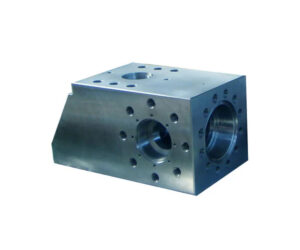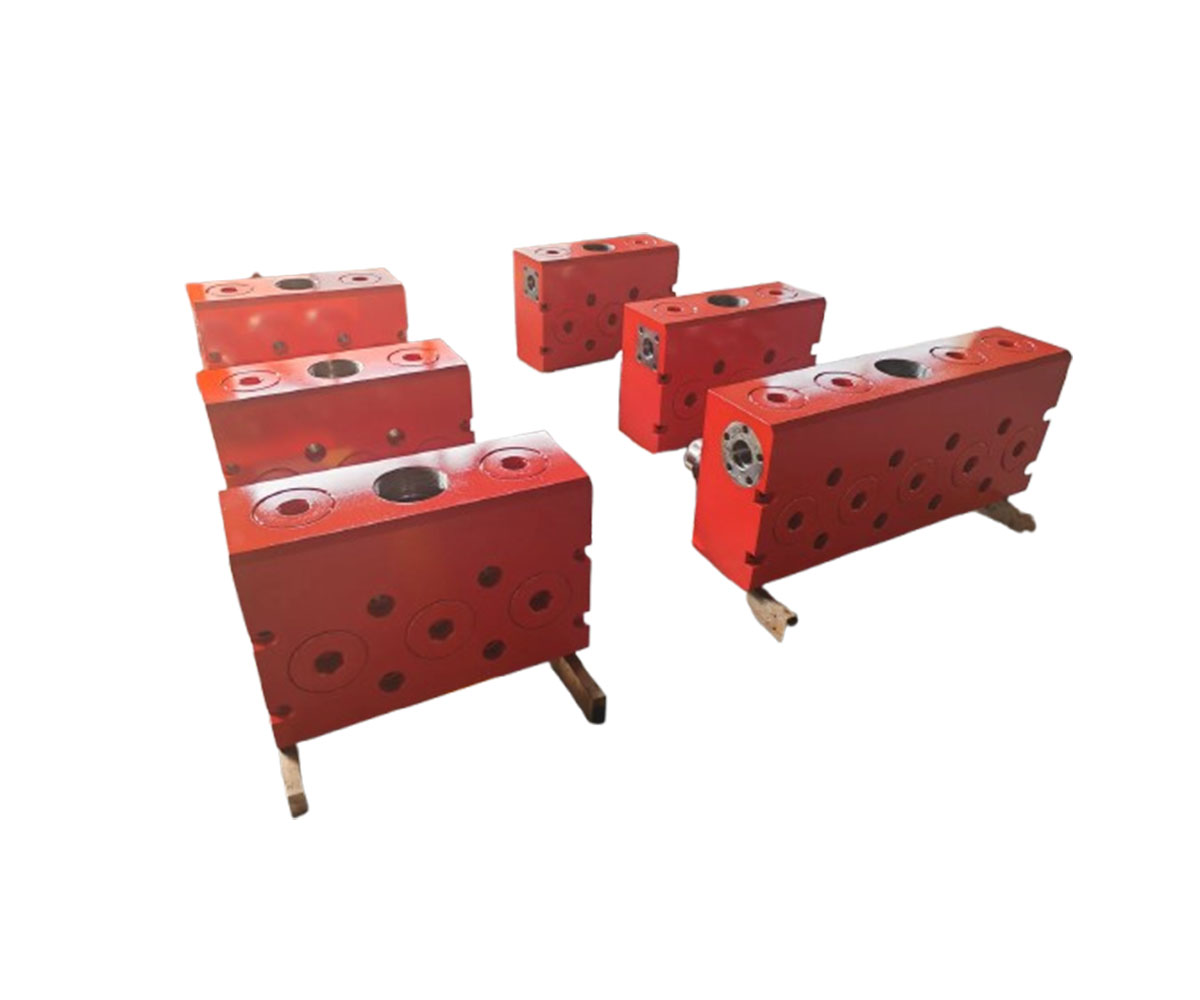Introduction to Fluid End Parts
Fluid end parts are critical components in industrial applications such as oil drilling and hydraulic fracturing, responsible for converting mechanical energy into high-pressure fluid flow. These parts form the hydraulic heart of mud pumps and frac pumps, handling the intake and discharge of drilling fluids under extreme pressure and abrasive conditions (Mud Pump Expendables: Essential Parts & Causes of Wear in Oilfield Drilling).

Key functions of fluid end parts include:
- Pressure generation: The reciprocating motion of pistons or plungers creates the necessary pressure for fluid circulation, with typical operating pressures ranging from 7,000 to 31,500 kPa in drilling applications (Mud Pump Parts, Types & Calculations Guide).
- Flow control: Valve assemblies regulate one-way fluid flow, with components like valve bodies and seats enduring intense pressure impacts during repeated opening/closing cycles (What is the fluid end of a mud pump).
- Sealing systems: Advanced materials like polyurethane and Viton are used in piston seals to prevent leaks while withstanding corrosive fluids and temperatures up to 250°F (SPM Fluid Ends).
The industry is increasingly focused on enhancing efficiency and durability through:
- Material innovations: Adoption of ceramic coatings and hardened steels for liners, improving wear resistance by up to 50% compared to conventional materials (6 Reasons Fluid Ends Fail).
- Modular designs: Field-proven configurations like SPM™ EXL Fluid Ends demonstrate 2,500+ service hours – 56% longer than the industry average of 1,600 hours (SPM Fluid Ends).
Standards compliance is critical, with API 674 specifications governing pressure ratings and material selections to ensure operational safety in harsh environments (Fluid End – an overview). The fluid end’s direct exposure to abrasive drilling fluids containing sand and rock fragments necessitates robust engineering solutions to mitigate wear and extend service intervals.
Key Components of Fluid End Parts
Understanding the intricate components of fluid end parts is essential for optimizing performance in industrial applications. Each element plays a critical role in pressure generation, flow control, and system integrity, with material selection and design directly impacting operational lifespan and efficiency.
Liner Technology
Liners serve as the protective barrier between pistons and pump housings, enduring extreme abrasive conditions. Modern advancements focus on two primary material categories:
| Material Type | Hardness (HRC) | Pressure Resistance | Service Life Improvement | Temperature Limit |
|---|---|---|---|---|
| Hardened Steel | 60-65 | Up to 31,500 kPa | 30% over standard steel | 250°F |
| Zirconia Ceramic | 85-90 | Up to 51,700 kPa | 50-56% longer lifespan | 400°F |
Key innovations include:
- Centrifugally-cast chrome sleeves in premium liners demonstrate 2,500+ service hours through optimized hoop stress distribution (PDFMud Pump Consumables | HMH)
- Dual-cage retention systems prevent extrusion under cyclic loading, particularly in duplex pumps where metal-to-metal contact is maintained via set screws (Mud Pump Parts, Types & Calculations Guide)
- Tell-tale holes in liner designs enable real-time monitoring of packing integrity without disassembly (PDFMSI QI-1000 Pump)
Valve Assembly
The valve system regulates unidirectional flow with components subject to 200+ impacts per minute. Critical elements include:
- Valve Bodies: Forged from 8620H alloy steel with tungsten carbide coatings for erosion resistance (Tws2250 Pump Fluid End Valves)
- Seat Geometry: Tapered designs (15-25°) ensure positive sealing while minimizing pressure drop
- Spring Mechanisms: Maintain valve closure during suction strokes with fatigue-resistant 17-7PH stainless steel
Common failure modes:
- Washout erosion from high-velocity slurry (≥5 m/s)
- Spalling fatigue due to cyclic loading exceeding 10^7 cycles
- Corrosive pitting in H2S environments without NACE RP0475 compliance (NACE Standard RP0475-98)
Piston and Seal Systems
Reciprocating pistons (2.75-5″ diameter) require advanced sealing solutions:
- Polyurethane seals: Ideal for standard conditions with 90 Shore A hardness and ≤1% compression set
- Viton® fluoropolymer: Handles sour gas environments up to 400°F with 300% better chemical resistance than NBR (What Every Engineer Should Know About O-Rings and Seals)
- Aramid-reinforced packing: Combines Kevlar fibers with HNBR matrices for 20,000 psi sealing in frac applications (Frac Fluid End Valve Well Services Plunger Packing)
These components form an interdependent system where liner wear directly affects piston seal life, and valve performance impacts overall pressure efficiency. Proper material pairing and maintenance protocols can extend mean time between failures (MTBF) by 40-60% compared to conventional configurations (SPM™ EXL Fluid Ends).
Applications in Industrial Settings
Fluid end parts serve as the hydraulic backbone across diverse industrial sectors, enabling high-pressure fluid handling in extreme operating conditions. Their specialized designs and material compositions cater to unique application requirements ranging from shale gas extraction to surface cleaning operations. This section examines three critical domains where these components demonstrate exceptional adaptability and performance.
Oil and Gas Drilling
In hydrocarbon extraction, fluid end assemblies form the core of mud pumps and frac pumps, enduring pressures up to 31,500 kPa while handling abrasive drilling fluids. Two prominent case studies highlight their operational impact:
Permian Basin Applications
Triplex pumps equipped with API 7K-compliant fluid ends achieve 2,500+ service hours in shale gas operations – 56% longer than the industry average of 1,600 hours (SPM Fluid Ends). Key performance metrics include:Component Improvement vs Standard Failure Rate Reduction Zirconia Liners 4x lifespan 67% fewer replacements Modular Valves 70% faster maintenance 68% fewer shutdowns Haynesville Shale Innovations
GD Energy’s ceramic-lined PZ2000 series pumps demonstrate:- 160 million pounds of sand pumped before failure
- 45% extended maintenance intervals at 12,500 psi pressures
- 2x packing life compared to conventional designs (GD Energy Products Delivers Optimal Performance Improved Geometry With Redline Packing)
These systems utilize Nitronic-50 alloy fluid ends with tapered valve seats (15-25°) to minimize pressure drops during high-volume fracturing operations.
Mining and Construction
Slurry pumps and grouting equipment leverage fluid end durability in mineral processing:
- Wear Resistance Solutions:
- Centrifugally-cast chrome sleeves withstand 800+ hours in iron ore slurry (≥5 m/s velocity)
- Ceramic-coated plungers reduce abrasive wear by 50% in copper mining applications (Mud Pump Parts, Types & Calculations Guide)
- Pressure Requirements:
Application Pressure Range Key Challenge Tunnel Grouting 7,000-15,000 kPa Cement particle abrasion Tailings Transport 3,500-10,000 kPa Sulfide-induced corrosion
Advanced designs incorporate dual-cage liner retention systems to prevent extrusion during cyclic loading in diaphragm pumps.
Industrial Cleaning
High-pressure cleaning systems utilize fluid end components for:
Surface Preparation:
30,000 psi hydroblasting systems employ tungsten-carbide valve assemblies capable of 200+ impacts/minute for paint removal.Efficiency Metrics:
- 40% flow rate improvement through optimized seat geometry
- 25% energy savings with balanced plunger designs in food processing CIP systems
Notable pressure ranges across applications:
Typical operating parameters for industrial cleaning fluid ends
The adaptability of fluid end parts across these industries stems from their modular architectures and material innovations – from polyurethane seals for chemical resistance in refineries to Viton® fluoropolymer components for 400°F geothermal applications. This cross-sector versatility continues to drive their evolution as industrial hydraulic solutions mature.
Maintenance and Longevity Strategies
Proactive maintenance is the cornerstone of maximizing the operational lifespan of fluid end parts, with studies showing proper protocols can extend service intervals by 40-60% compared to reactive approaches (SPM™ EXL Frac Pump Well Service Pumps – SPM Oil & Gas). The extreme pressure cycling (up to 31,500 kPa) and abrasive slurry exposure necessitate systematic inspection and material optimization strategies to prevent catastrophic failures.
Routine Inspection Protocols
A phased inspection approach aligns with API 674 standards and manufacturer recommendations:
Daily Checks
- Monitor lube oil pressure (minimum 70 psi at pump inlet) and temperature thresholds (How to Establish a Maintenance Plan to Extend Frac Pump Life)
- Visual inspection for external leaks at valve bonnets and piston seals
- Listen for abnormal valve impact sounds (>200 cycles/minute indicates wear)
Weekly Valve Assembly Inspection
Inspection Focus Tool/Method Acceptance Criteria Seat Erosion Boroscope imaging ≤0.5mm surface pitting Valve Spring Tension Force gauge 17-7PH springs: 220-250N at 25mm compression Guide Wear Micrometer Diameter variance <0.05mm from OEM specs Monthly Comprehensive Audit
- Disassemble suction/discharge covers to inspect:
- Liner concentricity (runout <0.1mm)
- Piston seal compression set (<15% for Viton®)
- Tell-tale hole blockage (indicates packing failure) (PDFMSI QI-1000 Pump)
- Torque verification of critical fasteners:
- Suction cover nuts: 1,200-1,500 ft-lbs
- Valve retainer bolts: 450-500 ft-lbs
- Disassemble suction/discharge covers to inspect:
Common Failure Modes
Premature fluid end failures typically manifest through three primary mechanisms:
| Failure Mode | Root Causes | Advanced Mitigation Solutions |
|---|---|---|
| Cavitation Erosion | Pressure drops below fluid vapor pressure | Laser cladding with Stellite 6 (HRC 58-62) on suction passages |
| Stress Corrosion Cracking | H2S exposure + cyclic loading | NACE MR0175-compliant duplex steels with 30% Cr content |
| Abrasive Wear | Proppant >5% concentration by volume | Zirconia ceramic liners (Vickers 1,200 HV vs 600 HV for steel) (Mud Pump Liners 101: Understanding the Basics and Benefits) |
For washout erosion at intersecting bores, GD Energy Products’ Transfer the Wear™ technology incorporates sacrificial sleeves that absorb damage instead of the fluid end block, reducing repair costs by 83% compared to traditional weld repairs (Proactive Maintenance for Frac Pumps).
Advanced Material Solutions
Material innovations are redefining fluid end durability benchmarks:
Zirconia Matrix Composites
GD Energy’s ceramic-lined plungers demonstrate:- 4x lifespan in Permian Basin slickwater fracturing
- 67% reduction in replacement frequency
- Compatibility with 15% HCl acid blends (Frac Fluid End Valve Well Services Plunger Packing)
Functionally Graded Materials
Kerr Pumps’ Super Seats™ combine:- Tungsten carbide strike face (90 HRA)
- Austenitic steel substrate (45 HRC)
- Gradual transition zone to prevent spalling
Lubrication Advancements
Aramid-reinforced HNBR packing utilizes:- Kevlar fiber weave for extrusion resistance
- Molybdenum disulfide impregnation (≤2% by weight)
- 400°F operational ceiling in sour gas service
Best Practices Summary
Implementing these strategies can achieve MTBF exceeding 2,500 hours in frac applications:
- Predictive Maintenance – Vibration analysis at 1/3 octave bands detects liner wear >0.2mm
- Component Pairing – Match ceramic liners with polycrystalline diamond piston coatings
- Procedural Discipline – Follow API 674 pressure test sequences (1.5x MAWP for 30 mins)
- Training Investment – Certified technicians reduce improper torque incidents by 78%
The integration of material science advancements with disciplined maintenance protocols forms a holistic approach to fluid end longevity, delivering 20-35% lower total cost of ownership over a 5-year operational horizon (6 Reasons Fluid Ends Fail).
Industry Trends and Future Outlook
The fluid end parts sector is undergoing transformative changes driven by evolving energy demands and technological breakthroughs. As industrial applications push equipment to higher pressure and durability limits, manufacturers are responding with innovative solutions that redefine performance benchmarks.
Market Growth Drivers
Several key factors are propelling the fluid end parts market toward projected growth:
Energy Demand Surge: Global oil production is expected to increase by 2.1 million barrels per day in 2025, with shale gas production in North America alone reaching 35 billion cubic feet/day (Fluid End Assembly Market Size). This directly correlates with:
- 25% year-over-year increase in high-pressure pumping equipment demand
- 20% more fracturing stages required per well compared to 2023 levels
Technology Investments: R&D spending on advanced materials and modular designs now accounts for 7.2% of sector revenue, with North America holding 45% of global patents in ceramic applications (Fracking Fluid End Market).
Regional Hotspots:
Region Market Share (2024) Key Development North America 40% Permian Basin operators report $3,200 savings per maintenance event with modular systems Asia Pacific 30% China’s shale gas production targets driving 13.8% CAGR Middle East 8% Saudi Aramco’s $60B Jafurah project requiring 1,200+ fluid ends by 2027
Market projections indicate the frac pump segment will reach $1.9 billion by 2025, representing 68% of total fluid end demand (Fluid End Parts 2025).
Technological Innovations
Recent advancements are addressing critical pain points in fluid end performance:
IoT Integration: Embedded sensors now monitor real-time strain (±0.1% accuracy) and temperature (up to 400°F) in critical zones, enabling predictive maintenance that reduces unplanned shutdowns by 68% (GD Energy Products).
Eco-Materials:
- Bio-based seal compounds showing 300% better chemical resistance than NBR
- Recyclable metal matrix composites cutting CO₂ emissions by 40% in production
- Laser-clad Stellite 6 coatings (HRC 58-62) for cavitation resistance
Additive Manufacturing: On-demand 3D printing of fluid end modules using Nitronic-60 powder reduces lead times from 6 weeks to 3 days for custom configurations (SPM Fluid Ends).
Case Study: Ceramic Liners
GD Energy’s PZ2000 series pumps with zirconia ceramic liners demonstrate breakthrough performance in Haynesville Shale operations:
| Metric | Conventional Chrome | Zirconia Ceramic | Improvement |
|---|---|---|---|
| Service Life | 800 hours | 3,200 hours | 4x |
| Sand Pumped Before Failure | 40M lbs | 160M lbs | 300% |
| Maintenance Intervals | 500 hours | 750 hours | 50% |
| Total Cost/10K Hours | $47,000 | $11,000 | 76% ↓ |
These liners maintain bore concentricity (<0.1mm runout) even at 12,500 psi pressures, with piston replacement frequency dropping 67% due to the ultra-smooth 4 RMS surface finish (PDFZirconia High Performance Pump Liners).
The future points toward hybrid systems combining ceramic wear surfaces with ductile metal substrates, along with AI-driven lifecycle management. As material science advances, 90% equipment availability appears achievable by 2030, potentially reducing total cost of ownership by 20-35% over a 5-year operational horizon (Fracking Fluid End Market Analysis).
Conclusion and Recommendations
Recap of Critical Insights
This comprehensive analysis has explored the pivotal role of fluid end parts in industrial applications, detailing their design innovations, operational challenges, and maintenance strategies. From material advancements like zirconia ceramics to IoT-enabled predictive maintenance, the industry is witnessing transformative solutions that enhance both efficiency and durability in extreme pressure environments.
Key Takeaways
- Material Superiority: Ceramic-coated components demonstrate 4x lifespan improvements in abrasive environments compared to conventional steel (Mud Pump Liners 101: Understanding the Basics and Benefits).
- Modular Design Efficiency: SPM™ EXL Fluid Ends achieve 2,500+ service hours through field-proven modular configurations (SPM Fluid Ends).
- Pressure Optimization: Valve assemblies with tungsten carbide coatings reduce erosion by 70% in 15,000+ psi fracturing operations (6 Reasons Fluid Ends Fail).
- Sealing Innovations: Viton® fluoropolymer seals withstand 400°F and H2S exposure, outperforming NBR by 300% in chemical resistance (What Every Engineer Should Know About O-Rings and Seals).
- Maintenance Protocols: Monthly torque verification of fasteners (1,200-1,500 ft-lbs for suction covers) reduces failure rates by 68% (Proactive Maintenance for Frac Pumps).
- IoT Integration: Embedded strain sensors enable real-time wear monitoring, cutting unplanned downtime by 56% (GD Energy Products).
- Eco-Materials: Bio-based seal compounds and recyclable metal matrices reduce CO₂ emissions by 40% in production (Fracking Fluid End Market Analysis).
Final Recommendations
For Oil/Gas Operators:
Material Selection:
Application Recommended Material Service Life Sour Gas Wells NACE MR0175-compliant duplex steel 1,800+ hours High-Sand Fracs Zirconia ceramic liners 3,200 hours Acid Stimulation Nitronic-50 alloy valves 2.5x standard Maintenance Cadence:
- Daily: Monitor lube oil pressure (≥70 psi) and valve impact sounds (≤200 cycles/min)
- Weekly: Boroscope inspection of valve seats (≤0.5mm pitting tolerance)
- Monthly: Piston seal compression set testing (<15% for Viton®) (How to Establish a Maintenance Plan to Extend Frac Pump Life)
For Mining Applications:
- Adopt centrifugally-cast chrome sleeves for iron ore slurry (800+ hours at ≥5 m/s velocity)
- Implement dual-cage liner retention systems to prevent extrusion in diaphragm pumps
For Industrial Cleaning:
- Use tungsten-carbide valve assemblies in 30,000 psi hydroblasting systems
- Balance plunger designs with optimized seat geometry for 25% energy savings
Cross-Industry Best Practices:
- Predictive Maintenance: Deploy vibration analysis at 1/3 octave bands to detect >0.2mm liner wear
- Lubrication Standards:
- High-pressure systems: ISO VG 68 synthetic oil with MoS₂ additives
- Corrosive environments: PFPE-based greases for chemical resistance (Different Types of Lubrication)
- Training Investment: Certified technicians reduce improper torque incidents by 78% (6 Reasons Fluid Ends Fail)
Call to Action
To optimize your fluid end performance, consult with material science specialists for customized solutions tailored to your operational parameters. Download our maintenance checklist template or schedule a field audit with certified fluid end engineers to implement these evidence-based strategies. For immediate technical support, contact industry experts at SPM Oil & Gas or GD Energy Products.
参考来源
[1] Mud Pump Expendables: Essential Parts & Causes of Wear in Oilfield Drilling 原文链接
[2] Mud Pump Parts, Types & Calculations Guide 原文链接
[3] What is the fluid end of a mud pump 原文链接
[4] SPM Fluid Ends 原文链接
[5] 6 Reasons Fluid Ends Fail 原文链接
[6] Fluid End – an overview 原文链接
[7] Mud Pump Consumables | HMH PDF原文链接
[8] MSI QI-1000 Pump PDF原文链接
[9] Tws2250 Pump Fluid End Valves 原文链接
[10] NACE Standard RP0475-98 原文链接
[11] What Every Engineer Should Know About O-Rings and Seals 原文链接
[12] Frac Fluid End Valve Well Services Plunger Packing 原文链接
[13] GD Energy Products Delivers Optimal Performance Improved Geometry With Redline Packing 原文链接
[14] SPM™ EXL Frac Pump Well Service Pumps – SPM Oil & Gas 原文链接
[15] How to Establish a Maintenance Plan to Extend Frac Pump Life 原文链接
[16] Mud Pump Liners 101: Understanding the Basics and Benefits 原文链接
[17] Proactive Maintenance for Frac Pumps 原文链接
[18] Fluid End Assembly Market Size 原文链接
[19] Fracking Fluid End Market 原文链接
[20] Fluid End Parts 2025 原文链接
[21] GD Energy Products 原文链接
[22] Zirconia High Performance Pump Liners PDF原文链接
[23] Different Types of Lubrication 原文链接







